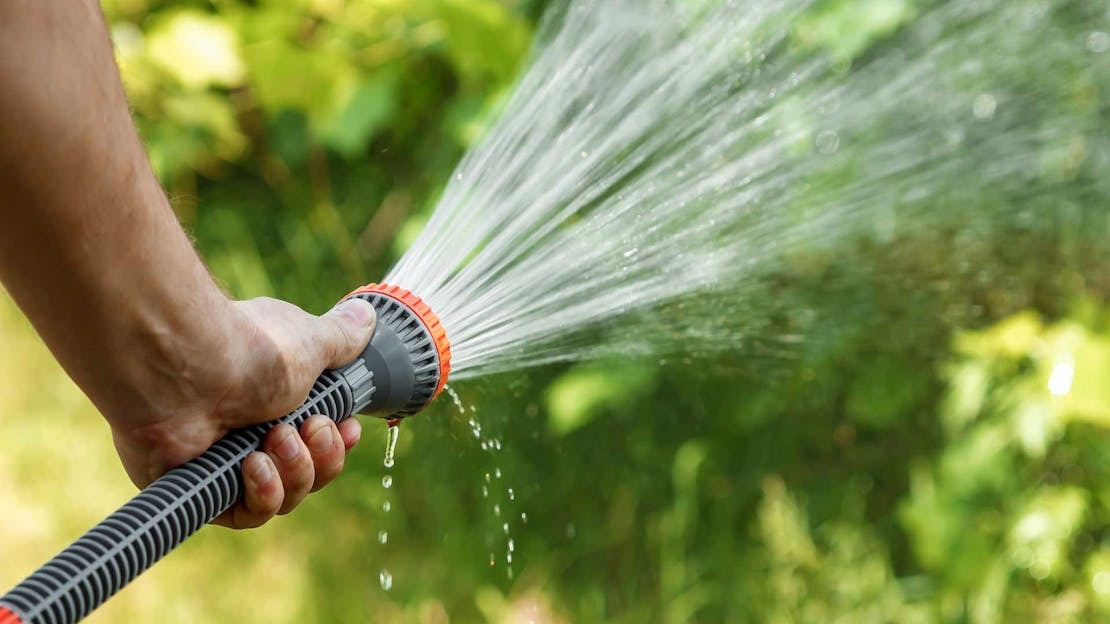
When to Water my Lawn; Before or After Fertilising?
Watering-in a fertiliser treatment is necessary for fine powdery products such as weed and feed so try using a fertiliser that doesn’t need watering in!
Watering-in a fertiliser treatment is very different from watering to keep the grass green and healthy. Using a fertiliser that doesn’t need watering-in is a far better idea.
Watering to keep the Grass Green and Healthy
This involves deep watering when the lawn needs it which would normally be in dry warm periods from late spring to early autumn.
To find out how to water the lawn correctly please visit Watering the Lawn.
Do not Feed a Dry Lawn
If there is little moisture in the soil then there is nothing to take the fertiliser to the roots and then the leaves. Dry soil usually means grass under stress so adding any granular feed, liquid feed, moss killer or weed killer can harm the grass.
Any fertiliser applied in dry conditions is a waste of money and fertiliser and can damage the lawn. See Lawn Burn
Why do you need to Water-in Lawn Fertiliser?
Some fertilisers need watering in and some don’t. We prefer the ones that don’t need watering in because they are invariably safer for the grass and easier for you to manage.
Lawn Fertilisers that need Watering In
These are usually fine granular or powdery products often containing weed killer and iron as a moss killer. These are commonly known as weed ‘n feed or 4 in 1 products.
Due to their fine nature they readily stick to grass leaves and during dry sunny weather this can start to burn the leaves. This is also why you are advised to keep children and pets off the lawn until watered in! After 2 or 3 days of application you should water the feed off the leaves and into the soil.
Lawnsmith Fertilisers DON’T need Watering In
You should not feed the lawn with any type of fertiliser in dry conditions and only feed when there is adequate soil moisture for the grass to be able to utilise your fertiliser. If you now apply a Lawnsmith granular or pelleted type of feed in the correct conditions this will bounce off the leaves and deep into the turf. These types of fertilisers rarely contain moss or weed killer making them much safer for lawn users.
Down at soil level the food can absorb moisture from the soil, dissolving deeper into the soil where the roots can then take the feed up into the grass plant. The benefits are:
- Easier for you to manage with far less hassle
- The lawn can be used straight after feeding
- Safer for the grass
- Safer for children, dogs and cats
- Less harm to the environment and wildlife as there are no pesticides
- Lower water bills
The fertilisers that fit into the 'no watering-in' category are shown at the bottom of the page.
Always Water before Feeding or Wait for Rain
All fertiliser requires soil moisture so it is best to water before feeding rather than after during dry conditions. This means that you can check the soil has moisture and then feed safely. This is even more important if waiting for rain before doing your feeding. If the forecast is an inch of rain then conditions should be excellent to feed, but what if the weather forecast is wrong and you only get a shower! If you've already applied your fertiliser you could be at risk of burning the grass. So, let it rain and if sufficient you can feed safely or water to top up and then feed safely.
With fine powdery products that state to water-in after, we would still recommend watering deeply before application to ensure high grass safety, particularly in dry conditions. If rain doesn't arrive within a few days then follow the recommendation on the product to water-in lightly.
With granular or pellet type feeds you have a far higher degree of grass safety without the hassle of this post feeding watering. You, the dog and the cat can also use the lawn straight after feeding.
To find out how to water the lawn correctly please visit Watering the Lawn.
When to use Liquid Fertiliser
Because liquid or soluble fertilisers work best by being absorbed through the grass leaves, particular care needs to be taken when applying. If moisture levels are low then fertiliser being a salt, applied to the grass leaves can cause damage very quickly. It is essential therefore, to have adequate moisture in the soil and for the grass to be actively growing before application. In addition, rain or water applied within 24 hours of the application can interfere with its efficacy. This means ALWAYS apply liquid feed after rain or watering and once the grass surface has dried.